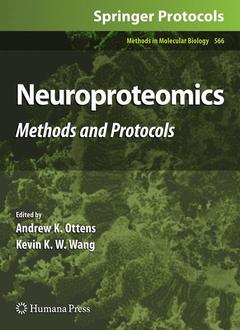Neuroproteomics, 2009 Methods and Protocols Methods in Molecular Biology Series, Vol. 566
Langue : Anglais
Coordonnateurs : Ottens Andrew K., Wang Kevin K.W.

Neuroproteomics: Methods and Protocols presents experimental details for applying proteomics to the study of the central nervous system (CNS) and its dysfunction through trauma and disease. The target audience includes clinical or basic scientists who look to apply proteomics to the neurosciences. Often researchers hear of proteomics without an adequate explanation of the methodology and inherent limitations. This volume conveys where proteomic methodology is in its application to CNS research and what results can be expected. We also address clinical translation of neuroproteomics, specifically in the area of biomarker research. The inception of neuroproteomics capitalized on rapid progress in large-molecule mass spectrometry over the last decade. Two seminal advances have spurred research ? development of reliable polypeptide ionization processes and bioinformatics to rapidly process tandem mass spectra for peptide identification and quantification. What has followed is the exponential application of mass spectrometry to proteome characteri- tion across biological and biomedical disciplines. Arguably, the most elaborate proteomic implementation is in studying the CNS, the most enigmatic and complex animal system. Neuroscience is characterized by grandiose questions ? what is consciousness, how does thought or memory work. Neuroproteomics researchers, however, have pri- rily involved themselves dysfunction, based on a pressing need (and invariably funding), in answering questions on CNS dysfunction, based on a pressing need (and invariably funding), and because such questions hold more accessible answers. Dysfunction is readily contrasted against normal function and presumably produces a lasting differential protein signature.
Disease Models in Neuroproteomics.- The Methodology of Neuroproteomics.- Modeling Cerebral Ischemia in Neuroproteomics.- Clinical and Model Research of Neurotrauma.- Neuroproteomic Methods in Spinal Cord Injury.- Modeling Substance Abuse for Applications in Proteomics.- Protein Aggregate Characterization in Models of Neurodegenerative Disease.- Sub-Proteome Separations and Neuroproteomic Analysis.- Sub-Proteome Processing: Isolation of Neuromelanin Granules from the Human Bra.- Proteomic Analysis of Protein Phosphorylation and Ubiquitination in Alzheimer’s Disease.- Proteomics Identification of Carbonylated and HNE-Bound Brain Proteins in Alzheimer’s Disease.- Mass Spectrometric Identification of In Vivo Nitrotyrosine Sites in the Human Pituitary Tumor Proteome.- Improved Enrichment and Proteomic Analysis of Brain Proteins with Signaling Function by Heparin Chromatography.- Calmodulin-Binding Proteome in the Bra.- Neuroproteomic Methodology and Bioinformatics.- Separation of the Neuroproteome by Ion Exchange Chromatography.- iTRAQ-Based Shotgun Neuroproteomics.- Methods in Drug Abuse Neuroproteomics: Methamphetamine Psychoproteome.- Shotgun Protein Identification and Quantification by Mass Spectrometry in Neuroproteomics.- Biofluid Analysis and Clinical Translation.- Identification of Glycoproteins in Human Cerebrospinal Fluid.- Mass Spectrometric Analysis of Body Fluids for Biomarker Discovery.- Traumatic Brain Injury Biomarkers: From Pipeline to Diagnostic Assay Development.- Translation of Neurological Biomarkers to Clinically Relevant Platforms.
Presents a modular approach to experimental design, covering neurodegenerative models, subproteome selection technologies, quantitative and qualitative mass spectrometry, data analysis and clinical translation of results Detailed guide to developing, running and analyzing broadly applicable neuroproteomic experiments Provides specifics and insight to perform the latest quantitative and subproteome analyses, including key post-translational modifications Covers a wide range of model systems used in neuroproteomic research, including ischemia, brain and spinal cord injury, substance abuse and neurodegenerative disease Expands beyond the lab bench in providing guidance on translating neuroproteomic results to the clinic
Date de parution : 07-2012
Ouvrage de 321 p.
19.3x26 cm
Date de parution : 08-2009
Ouvrage de 321 p.
19.3x26 cm
Thèmes de Neuroproteomics :
© 2024 LAVOISIER S.A.S.



